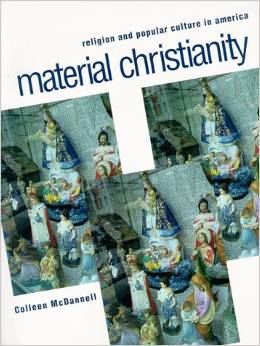
Material Christianity
Colleen McDannell (Yale University Press: Jan 24, 1996), 328 pages.It’s tough to be devout and kitschy at the same time, but Colleen McDannell strikes that delicate balance with admirable poise in Material Christianity: Religion and Popular Culture in America. Her book is an argument that “American Christians … want to see, hear, and touch God. It is not enough for Christians to go to church, lead a righteous life, and hope for an eventual place in heaven.” This argument is amply defended by smart essays about family Bibles, gravestone design, and Lourdes Water, as well as hundreds of illustrations of vestments, churches, portraits of Jesus, rapture T-shirts, and backyard statues of Our Lady. Where Material Christianity gets really interesting, however, is in its assertion that “Christian material culture does not simply reflect an existing reality. Experiencing the physical dimension of religion helps bring about religious values, norms, behaviors, and attitudes.” For example, the warmth and intimacy of Warner Sallman’s painting “Head of Christ,” which hung in almost every Protestant Sunday School classroom in America until the 1960s, was probably every bit as influential as any given phrase from the Sermon on the Mount in determining the personal nature of Protestants’ relationships with Jesus. Material Christianity covers a lot of ground — from Mormonism to fundamentalism — and every chapter is as theologically wise as it as aesthetically astute. ~ Amazon.com
Synopsis
What can the religious objects used by nineteenth- and twentieth-century Americans tell us about American Christianity? What is the relationship between the beliefs of the faithful and the landscapes they build? This lavishly illustrated book investigates the history and meaning of Christian material culture in America over the last 150 years. Drawing on a rich array of historical sources and on in-depth interviews with Protestants, Catholics, and Mormons, Colleen McDannell examines the relationship between religion and mass consumption. McDannell claims that previous studies of American Christianity have overemphasized the written, cognitive, and ethical dimensions of religion, presenting faith as a disembodied system of beliefs. She shifts attention from the church and the theological seminary to the workplace, home, cemetery, and Sunday school. Thus McDannell highlights a different Christianity – one in which average Christians experience the divine, the nature of death, the power of healing, and the meaning of community through interacting with a created world of devotional images, environments, and objects.
BookList
McDannell is concerned with physical and material expressions of religion often overlooked in discussion of American Christianity. She is critical of approaches to secularization and religion that shift attention from material dimensions of religion to “religious” dimensions of secular material culture. These approaches, which she associates with distrust of the material and the masses, are evident in Protestant emphasis on the written word at the expense of unwritten practice and in critical traditions associated with the Frankfurt school that understand mass culture as manipulation made possible by the “weak egos and submissive psyches” of the masses. The Frankfurt school’s Marxist roots incline toward appreciation of the material, but they are “protestant” enough to associate criticism with the words of a revolutionary elite that rises above the material practice of the masses. To her credit, McDannell is interested not in “rising above” that practice but in examining it as an expression of culture. She does this in a series of carefully documented and clearly written case studies ranging from Roman Catholic sacramentals through the rural cemetery movement to Mormon garments and Christian retailing. The careful intertwining of theory and practice in historically informed case studies is exemplary for readers with a specific interest in material Christianity as well as those with a more general interest in material culture and the making of meaning.
Table of Contents
-
- Acknowledgments
- Illustration Credits
- 1. Material Christianity 1
- 2. Piety, Art, Fashion: The Religious Object 17
- 3. The Bible in the Victorian Home 67
- 4. The Religious Symbolism of Laurel Hill Cemetery 103
- 5. Lourdes Water and American Catholicism 132
- 6. Christian Kitsch and the Rhetoric of Bad Taste 163
- 7. Mormon Garments: Sacred Clothing and the Body 198
- 8. Christian Retailing 222
- Epilogue 270
- Notes 277
- Index 306